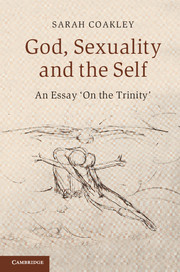Book contents
- Frontmatter
- Contents
- Illustrations
- Preface and acknowledgements
- Abbreviations
- Prelude: the arguments of this book
- Chapter 1 Recasting ‘systematic theology’: gender, desire, and théologie totale
- Chapter 2 Doing theology ‘on Wigan Pier’: why feminism and the social sciences matter to theology
- Chapter 3 Praying the Trinity: a neglected patristic tradition
- Chapter 4 The charismatic constituency: embarrassment or riches?
- Chapter 5 Seeing God: trinitarian thought through iconography
- Chapter 6 ‘Batter My Heart’: reorientations of classic trinitarian thought
- Chapter 7 The primacy of divine desire: God as Trinity and the ‘apophatic turn’
- Coda: conclusions and beyond
- Glossary of technical terms and names
- Scripture index
- General index
- References
Chapter 5 - Seeing God: trinitarian thought through iconography
Published online by Cambridge University Press: 05 June 2014
- Frontmatter
- Contents
- Illustrations
- Preface and acknowledgements
- Abbreviations
- Prelude: the arguments of this book
- Chapter 1 Recasting ‘systematic theology’: gender, desire, and théologie totale
- Chapter 2 Doing theology ‘on Wigan Pier’: why feminism and the social sciences matter to theology
- Chapter 3 Praying the Trinity: a neglected patristic tradition
- Chapter 4 The charismatic constituency: embarrassment or riches?
- Chapter 5 Seeing God: trinitarian thought through iconography
- Chapter 6 ‘Batter My Heart’: reorientations of classic trinitarian thought
- Chapter 7 The primacy of divine desire: God as Trinity and the ‘apophatic turn’
- Coda: conclusions and beyond
- Glossary of technical terms and names
- Scripture index
- General index
- References
Summary
This chapter is devoted to exploring my supposition that Christian art, and indeed the realm of the imagination in general, must hold an indispensable place in a feminist théologie totale. The testing ground for this thesis in this volume will be an examination of significant examples from the history of the iconography of the Trinity. My previous two ‘foraging raids’ into the tradition (via patristic theories of prayer, and contemporary fieldwork on charismatics) have established revealing social patternings in the history and contemporary practice of trinitarian belief, and have brought to consciousness the ‘messy entanglements’ of political, sexual, and doctrinal agendas in any such trinitarian thinking and expression. We have by now seen the heady mingling of themes of desire and pain, politics and authority, gender and empowerment, with this normative trinitarian doctrine of the faith in any of its particular manifestations. Both in neglected texts, and in neglected personal narratives from the field, the doctrine of the Trinity has been cast into new light, and it has begun to become clear how many ‘levels’ of reflection on a central doctrine are relevant to a théologie totale. It is now time to investigate the aesthetic realm, the powerful arena of fantasy and of the imagination, and see what this adds further and creatively to our theological reflection.
In moving to examine iconographic expressions of the Trinity, part of what I shall be looking for, first, is some sort of substantiation or supplementation of my thesis of thematic ‘entanglement’ – in this case between art, gender, politics, and theology. What will become manifest in this chapter is that the visual representation of a doctrine in cultural artifacts (especially one that seeks to portray, as in the Trinity itself, ideal divine ‘relations’) is often hugely revealing of coded and subliminal messages about normative human relations in society, church, and family. ‘The medium is the message’ indeed; and representations of power and gender that are given as doctrinally ‘orthodox’, but simultaneously carry all kinds of extra social and political ballast, demand close and critical attention.
- Type
- Chapter
- Information
- God, Sexuality, and the SelfAn Essay 'On the Trinity', pp. 190 - 265Publisher: Cambridge University PressPrint publication year: 2013



